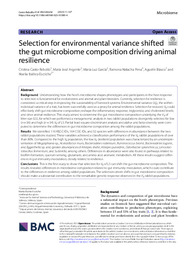Por favor, use este identificador para citar o enlazar este ítem:
https://hdl.handle.net/11000/30917Registro completo de metadatos
| Campo DC | Valor | Lengua/Idioma |
|---|---|---|
| dc.contributor.author | Casto-Rebollo, Cristina | - |
| dc.contributor.author | Argente, María José | - |
| dc.contributor.author | Garcia Pardo, Maria Luz | - |
| dc.contributor.author | Pena, Romi | - |
| dc.contributor.author | BLASCO, AGUSTIN | - |
| dc.contributor.author | Ibanez-Escriche, Noelia | - |
| dc.contributor.other | Departamentos de la UMH::Tecnología Agroalimentaria | es_ES |
| dc.date.accessioned | 2024-02-01T08:17:23Z | - |
| dc.date.available | 2024-02-01T08:17:23Z | - |
| dc.date.created | 2023-07-04 | - |
| dc.identifier.citation | Microbiome 11, 147 (2023) | es_ES |
| dc.identifier.issn | 2049-2618 | - |
| dc.identifier.uri | https://hdl.handle.net/11000/30917 | - |
| dc.description.abstract | Background. Understanding how the host’s microbiome shapes phenotypes and participates in the host response to selection is fundamental for evolutionists and animal and plant breeders. Currently, selection for resilience is considered a critical step in improving the sustainability of livestock systems. Environmental variance (VE), the withinindividual variance of a trait, has been successfully used as a proxy for animal resilience. Selection for reduced VE could effectively shift gut microbiome composition; reshape the inflammatory response, triglyceride, and cholesterol levels; and drive animal resilience. This study aimed to determine the gut microbiome composition underlying the VE of litter size (LS), for which we performed a metagenomic analysis in two rabbit populations divergently selected for low (n = 36) and high (n = 34) VE of LS. Partial least square-discriminant analysis and alpha- and beta-diversity were computed to determine the differences in gut microbiome composition among the rabbit populations. Results. We identified 116 KEGG IDs, 164 COG IDs, and 32 species with differences in abundance between the two rabbit populations studied. These variables achieved a classification performance of the VE rabbit populations of over than 80%. Compared to the high VE population, the low VE (resilient) population was characterized by an underrepresentation of Megasphaera sp., Acetatifactor muris, Bacteroidetes rodentium, Ruminococcus bromii, Bacteroidetes togonis, and Eggerthella sp. and greater abundances of Alistipes shahii, Alistipes putredinis, Odoribacter splanchnicus, Limosilactobacillus fermentum, and Sutterella, among others. Differences in abundance were also found in pathways related to biofilm formation, quorum sensing, glutamate, and amino acid aromatic metabolism. All these results suggest differences in gut immunity modulation, closely related to resilience. Conclusions. This is the first study to show that selection for VE of LS can shift the gut microbiome composition. The results revealed differences in microbiome composition related to gut immunity modulation, which could contribute to the differences in resilience among rabbit populations. The selection-driven shifts in gut microbiome composition should make a substantial contribution to the remarkable genetic response observed in the VE rabbit populations | es_ES |
| dc.format | application/pdf | es_ES |
| dc.format.extent | 9 | es_ES |
| dc.language.iso | eng | es_ES |
| dc.publisher | BMC | es_ES |
| dc.rights | info:eu-repo/semantics/openAccess | es_ES |
| dc.rights.uri | http://creativecommons.org/licenses/by-nc-nd/4.0/ | * |
| dc.subject | Animal resilience | es_ES |
| dc.subject | Microbiome | es_ES |
| dc.subject | Rabbits | es_ES |
| dc.title | Selection for environmental variance shifted the gut microbiome composition driving animal resilience | es_ES |
| dc.type | info:eu-repo/semantics/article | es_ES |
| dc.relation.publisherversion | https://doi.org/10.1186/s40168-023-01580-4 | es_ES |

Ver/Abrir:
Microbiome Argente.pdf
2,63 MB
Adobe PDF
Compartir:
 La licencia se describe como: Atribución-NonComercial-NoDerivada 4.0 Internacional.
La licencia se describe como: Atribución-NonComercial-NoDerivada 4.0 Internacional.
.png)